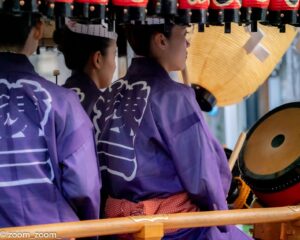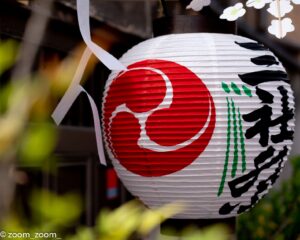Today (May 19) was the 3rd and last day of “Sanja Matsuri” for the year held in Asakusa, Tokyo. This is a Shinto festival, one of the three most magnificent festivals in Tokyo. I visited there and enjoyed myself viewing how local people in Asakusa were crazy about the festival!
“Sanja Matsuri” is held in mid-May every year by the parishioners of Asakusa Shrine where the three deities are enshrined. On the 3rd day, three Mikoshi or portable shrines where the three deities temporarily reside are carried out from Asakusa Shrine by its parishioners to march through 44 neighboring towns. There are two main purposes for the Mikoshi procession; one is to thank and entertain the deities; the other is to expect them to provide the divine protection for towns and people living in Asakusa. You will be surprised to see the people swinging the portable shrines violently during the procession. But it is to heighten the mystic powers of the deities.

Asakusa Shrine is dedicated to the three defined human beings who contributed to the foundation of Sensoji Temple in Asakusa, Tokyo. Out of the three, two are fishermen who found a Buddhist statue while fishing in the Sumida River and the other is the village chief who recognized the holiness of the stature and renovated his own house to enshrine the statue. The story dates back to the 7th century, being a background of how Sensoji Temple, the oldest temple in Tokyo, was founded. Actually, Sensoji Temple and Asakusa Shrine are located on the shared properties in Asakusa.

Do you start thinking why the story allows two religions to co-exist with harmony, Shintoism for Asakusa Shrine and Buddhism for Sensoji Temple? The situation is called syncretism or the fusion of Shintoism and Buddhism. Shintoism is an indigenous religion to Japan. It has no founder, no dogma, no scripture but it is based on the worship of nature and ancestors. People believe that a Shinto deity resides in every object of nature from a tree, a stone, a mountain, a river, whatsoever, and revere ancestors who made great contribution to the society. Shinto is polytheistic. Buddhism was founded by Shakyamuni in ancient India and was introduced to Japan in the 6th century. It has dogma and scriptures but no almighty god. So, it is considered atheistic. In Japan, since the introduction of Buddhism, the two religions have coexisted, which is very unique as, in other parts of the world, religions often fight each other.
I wish you plan to travel to Japan, visit shrines and temple which are often situated on the same properties, and have a chance to think syncretism … or simply enjoy seeing festivals held at shrines and temples!

May 19, 2019
By Hitoshi (Jin) Shibata
Email: jin.shibata@i3ws.co.jp,
